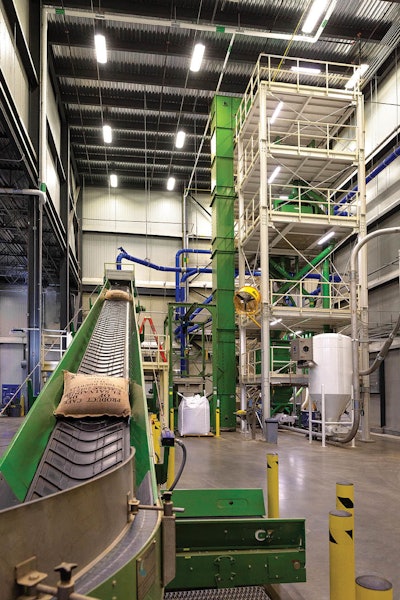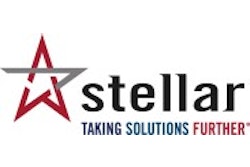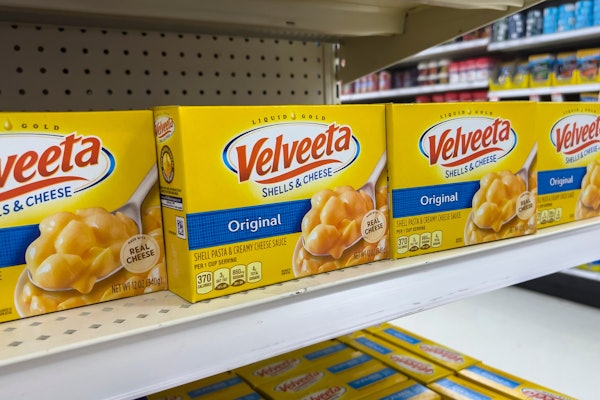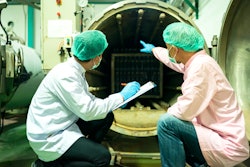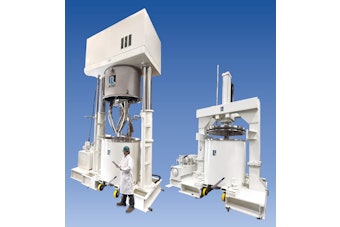Royal Cup Coffee and Tea has come a long way since 1896 when original company owner Henry T. Batterton sold coffee from a horse and wagon in Alabama. After Batterton and his wife died in a tragic car accident during the 1920s, bankers managed the company until the 1950s, when Billy Smith returned from World War II and bought the business along with two minority shareholders.
Smith changed the company name to Royal Cup Coffee, based on Batterton’s slogan — a royal cup of coffee. The rest is history, as the saying goes, and today, Billy’s grandson, Bill Smith III, serves as CEO. Royal Cup now has the capacity to handle up to 120 million lb of green coffee beans with the recent completion of a multiphase project that includes a new 33,150-sq-ft green bean receiving, cleaning and storage facility; expansion and renovation of its main roasting and packaging facility from 113,000 sq ft to 130,000 sq ft; a warehouse expansion of 11,000 sq ft; and a 4,000-sq-ft enclosed bridge between the roasting/packaging facility and the storage warehouse.
This project was honored as ProFood World’s 2019 Manufacturing Innovator of the Year award winner during a special presentation on March 27 during ProFood Tech 2019 in Chicago. (To learn about other Manufacturing Innovation Award winners and ProFood Tech, visit https://bit.ly/2ZNfv2i.)
The new campus allows Royal Cup to move raw coffee beans directly from the receiving dock to the cleaner and into storage mechanically. Plus, automated scanning inputs new inventory into Royal Cup’s new supervisory control and data acquisition (SCADA) system automatically, meaning the company knows exactly what products it has in stock.
Cutting-edge innovations in the green bean receiving facility include telescopic conveyors, automatic bag slitters and a custom pipe bridge for bean transport.
“The telescopic conveyors eliminate the need for manual unloading, which saves time and eliminates forklift accidents that could injure employees and ruin product,” states Kevin Boughner, senior vice president of operations at Royal Cup Coffee and Tea. “We took a three-shift unloading operation and streamlined it into one,” he adds.
Rather than the conventional method of manually cutting bags with a knife, automatic slitting equipment allows beans to enter the hopper for cleaning and disposes of the sack, reducing worker safety and food safety risks while improving efficiency.
Weekend warriors remove bottlenecks
The complex project began by building the green coffee beans facility. In the past, receiving was one of Royal Cup’s biggest production bottlenecks. “We would accept trucks with 40,000 lb of coffee, but the biggest bin we could put beans in was 10,000 lb,” explains Boughner. “The new facility completely reshaped our business potential. Now we have 32 silos capable of storing 1.2 million lb of coffee.”
At the green bean facility, incoming coffee is cleaned in a dry process to remove any foreign materials from origin and then placed in the silos. When a recipe is ready for processing, clean coffee beans are sent pneumatically via a bridge to the roasting plant. A custom transport system minimizes bean breakage as coffee beans travel that distance.
Royal Cup’s coffee production peaks from September through December, so much of the project work needed on the existing facility had to be done before that timeframe. “We put on a new roof, new walls and did a lot of floor work while we were operating the plant,” recalls Boughner.
During two, nine-month periods of the three-year project, Royal Cup gridded off certain areas of the existing production plant. The operations team had pre-meetings on Thursdays to communicate where construction and renovation would happen that weekend. The goal was to complete 20 different sections of the plant over the multiple weekends.
“On Friday afternoon, we would do a formal pass off to construction. On Sunday afternoon, our food safety team would come in to sign off that the plant was ready for food production,” explains Boughner.
In the roasting plant upgrade, Royal Cup installed a new Probat R2000 and upgraded its existing Probat R2000Z as well as the controls on its Probat RZ4000.
Roasted coffee is sent to whole bean packaging or to the grinding area before being sent to one of the 18 rebuilt packaging machines. Royal Cup also built a state-of-the-art-flavor room for ground coffee. If a recipe calls for flavored coffee, the system will pull the ground coffee into the blender, pull the right amount of flavoring out of the flavoring tanks and create a batch. Once it’s complete, the batch moves to the aggravating line.
When switching from a batch of hazelnut-flavored coffee to chocolate, for example, Royal Cup needed an efficient way to thoroughly clean the blending equipment to reduce flavor cross-contamination. Engineering and construction firm Stellar transformed the flavor room into a washdown area with high levels of food safety standards. The highly automated flavor room replaced a very manual previous process.
MES, SCADA systems provide tighter control, help increase throughput
Royal Cup’s process includes an advanced SCADA system designed by Factora that integrates all of the facility’s equipment. The green bean receiving system allows the plant’s various machinery and storage silos to communicate with each other and provide real-time feedback. “The system continually monitors and reacts to this data to improve the efficiency of product flow,” explains Kurt Warzynski, Stellar’s vice president of process engineering.
The beans are tracked multiple times after passing through the automatic slitter, after cleaning, after leaving the storage silos, and both before and after roasting. Bean weighing is also monitored in real time. The process data allows Royal Cup to display a continually updated reading of cycle levels, monitor weight discrepancies to ensure accurate inventory, and prompt the cleaning tower to automatically adjust conveyor speeds based on the weight of the sacks received.
“This is giving us tighter control of our margins and a better foundation to run our business,” states Boughner. The SCADA system also tracks downtime accurately. This high volume of data helps Royal Cup accurately understand efficiency losses and opportunities for improvement throughout the entire process. The system can also prompt personnel to address problems occurring on the line.
According to Tom Burris, Royal Cup’s senior vice president of supply chain, the manufacturing execution system (MES) automates and combines receiving, cleaning and storing in one step. “Upon receipt, the beans are in storage, ready for blending and use in the roasting plant,” he explains. “Additionally, we integrated that process with our SAP system so that when receiving, we’re doing many quality and SAP transactional checks to ensure that we’re unloading the correct beans from the correct purchase order, documenting traceability, and ensuring the process path is correct so there is no opportunity to mix beans.”
Steve Heiberger, Royal Cup’s director of engineering and maintenance, says the project also created labor efficiency, but, more importantly, upgraded its traceability powers. “We’ve got the ability to know each batch out of the roaster and trace that all the way back to which P.O. it came in on, what day it was received, and all the details around it, such as who cupped it and what container ship it came on,” he adds.
Royal Cup’s SAP Business Analyst Tres Robinson says that every pound of incoming coffee is measured before it’s cleaned. “Then we measure and weigh after it’s been cleaned, so we know shrinkage and how much we lose for metal separation, for example. We know this by lot and can provide feedback to our supplier,” says Robinson.
Burris says the biggest challenge in creating the MES was conceptualizing it. “We had to literally visualize what we were trying to accomplish and bring in all the new requirements from all the different [internal] constituencies,” he states. “We had to marry that process on paper to the physical equipment we purchased to make sure that we could design an MES system that would accomplish each of the constituents’ needs and work with the equipment.”
“The next challenge,” he says, “was integrating the equipment in the various vendor software packages into one MES system so that we could achieve the objectives through the various independent pieces of equipment.”
Testing is key to an integrated system, states Burris. “It’s easy to plan for a process that runs ideally, but what if there’s a power outage in the middle of a process, if the connection to your ERP (enterprise resource planning) system fails, or if a piece of equipment stops or backs up?”
The advanced MES is not just tracking and recording statistics on the performance of the process, but is actually controlling the process. The MES is integrated into equipment startup and equipment operation. “One of the things we had to work hard early on and work hard to maintain is to make sure the MES and all the pieces within, equipment wise, are maintained properly,” says Boughner. “Otherwise, the process would physically not start. If one piece goes down, it would prevent the rest of the process from starting.” This project is a success, but has certainly required a higher level of diligence in planning, he adds.
Burris says another benefit of the system has been the accuracy of scaling and weighing. “If a blend is outside the stated tolerance level, this system will automatically reject that blend. We’ve taken that out of the operators’ hands, so there’s no decision,” he says. “Secondly, it resulted in a much more consistent, higher-quality blend of coffee for our consumers to taste.”
By comparing feedback to the historical data and benchmarks, the SCADA system can detect if there is unusual loss of product occurring and aid in pinpointing the source of the problem, says Warzynski. “This technology allows quick resolution of any issues, resulting in less product waste and more efficient production.”
The most challenging part of this project was operating the plant during construction, says Boughner. “The second hardest part was the green coffee building and the development of the MES. To do the things we aspire to do in terms of traceability really put a burden on the design of the system and the execution of the MES.” In fact, Royal Cup spent four months getting this part of the project right. “We switched over and never looked back,” states Boughner.
Next on Royal Cup’s agenda is to tie its packaging system with the MES. “We just rebuilt the packaging machines, so we’ve got PLCs (programmable logic controllers) that are collecting data,” states Boughner.
Further investments produce more efficiency
Nearly $8 million of the project’s budget was spent on SQF upgrades, such as new metal wall panels, curb stops and refurbished floors. In addition to the flavor room upgrades mentioned earlier, Stellar installed new air handling equipment in both the new and renovated areas to create a positive air pressure flow. Royal Cup also invested in a state-of-the-art system to combat dust byproduct issues.
The new green bean facility was designed not only to improve how the product is received, but to ensure coffee beans are clean when ready for processing. Central vacuum receivers are located on the ground level, with more lines running to various cleaning locations on equipment platforms and mezzanines. This prevents foreign materials from passing into the processing and packaging areas on lower levels. The central vacuum system provides effective dry cleaning in both the new green bean facility and the renovated manufacturing areas.
In addition, energy efficiency has been created by increasing heating and ventilating efficiencies, thanks to an upgraded thermal envelope that also improves employee comfort.
“With the insulated metal panels and the airflow, we were able to cool the building and keep it warmer, as needed,” says Boughner.
The facility is also collecting pure waste streams, such as burlap and chaff, which is used in organic farming or to make fireplace logs, for example. Royal Cup also set up collection for co-mingled recycling and landfill-only material. In addition, the plant upgraded to state-of-the-art emission equipment.
Royal Cup hired Hoar Program Management (HPM) as a project consultant to support local market pricing efforts. Having a project consultant was a huge help on decisions like concrete price, for example,” states Boughner. “Even though Stellar and HPM have construction companies that compete against each other, they, without hesitation, refer one another,” Boughner says. “And I think that was what I was proudest of. It was very healthy for the project.”
The project was officially completed in August 2017, but Royal Cup’s vision continues as it prepares for the future with room for growth and flexibility. “When we are ready for the next roaster, we just have to order it, plug it in and keep rolling,” states Boughner.
“These upgrades have been truly invaluable. We now understand our business better than ever,” says CEO Bill Smith.
Read about how design-build helped Royal Cup Coffee and Tea remain operational during its renovation at https://www.profoodworld.com/articles/design-build-flexibility.
In addition to Royal Cup Coffee and Tea, HP Hood and Just Born also won ProFood World's Manufacturing Innovation Awards this year. Read about their projects at https://www.profoodworld.com/articles/standing-room-only-crowd-attends-manufacturing-innovation-awards.
Learn more about innovative equipment and technology that will help your plant increase efficiencies at PACK EXPO Las Vegas from Sept. 23-25 at the Las Vegas Convention Center. Register by Aug. 30 to save 70 percent off the registration fee.
Delivering a wide array of products
Royal Cup Coffee and Tea has a foodservice group, an office coffee group and a convenience store group while also providing contract manufacturing.
As the company grew, Royal Cup determined its customers wanted it to package their coffee, but control their own distribution. Within the foodservice division, Royal Cup provides products for not only foodservice, but for commissaries. Its convenience store group is a specialized part of the foodservice group.
The plant also produces whole bean packages for restaurants and hotels. In addition, it makes drip packs used in office coffee pots and provides contract manufacturing services. Royal Cup’s own brands include Prideland, Royal Cup Signature, ROAR and H.C. Valentine.
“We’ve got a cold brew liquid operation that we’re bringing on-site soon,” says Kevin Boughner, Royal Cup’s senior vice president of operations. “It will allow Royal Cup to produce ready-to-drink beverages in addition to concentrates and other forms of liquid coffee.”
“Office expectations have changed,” states Boughner. “They want the coffeehouse experience.” The trend has helped Royal Cup grow its business.
The company also produces iced tea at this plant. Its flavored teas are made at another location. In addition to its coffees and teas, the company provides a full range of beverage equipment, supplies and condiments.
